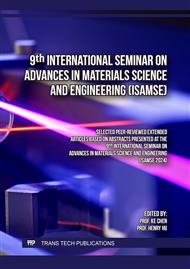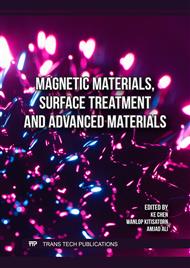[1]
Ji Xiaomei. Long-term anti-corrosion measures and maintenance construction techniques for bridge steel structures [J].Transpo World, 2022, 35:139-141.
Google Scholar
[2]
Zhang Yu. Current status of anti-corrosion technology for steel structure bridges [J]. Inner Mongolia Science Technology & Economy, 2021, 16:97-98.
Google Scholar
[3]
Xu Jinyong, Wu Qingdan, Wei Xinlong, et al. Research progress on arc-sprayed metal coatings for seawater corrosion protection [J]. Materials Report, 2020, 34(7): 13155-13159, 13174.
Google Scholar
[4]
Sun Chao, Han Lin. Development and application of anti-corrosion technology for steel bridges at home and abroad[J]. Urban Roads Bridges & Flood Control, 2011, 7:127-128.
Google Scholar
[5]
Sun Yuenan, Song Shenyou, Fan Chuanbin. Intelligent Coating Techniques Used for Steel Box Girders in Bridges of Shenzhen-Zhongshan Link [J]. World Bridges, 2023, 51(3):51-57.
Google Scholar
[6]
Chao Yu, An Yunqi, Shen Yatan, etal.. Development and application of nano-modified industrial anti-corrosion coatings [J], Electroplating & Finishing, 2010, 29(1):53-56.
Google Scholar
[7]
Han Yuying, Liu Ziliang, Wang Wenxue, et al. Application and development progress of graphene in the field of organic anti-corrosive coatings [J]. Surface Technology, 2021, 50(1): 196-207, 286.
Google Scholar
[8]
Li Haoran, Wang Gaosong. Research Status of Thermal Spraying and Aluminum-Based Anti-corrosive Coatings [J], Nonferrous Metals Processing, 2023, 52(3):1-5.
Google Scholar
[9]
Jia Hengqiong, Wang Tao, Wu Shaoliang, et al.Study on Corrosion Resistance of Thermal Sprayed Zn-Al Coating[J]. Advanced Materials of High Speed Railway, 2023, 2(2): 22-27.
Google Scholar
[10]
Deng Chunyin, Liu Chengwei, Lu Haifeng, et al. Effect of vacuum sealing on corrosion resistance of high-speed arc spraying coating [J]. Thermal Spray Technology, 2021, 13(3): 57-64.
Google Scholar
[11]
Li Yunde, Zhang Liang, Jiang Xiaogang, Yang Zhenbo . Design of anticorrosion coating system for modern bridge steel structure [J]. Electroplating & Finishing, 2011, 30(1): 57-62.
Google Scholar
[12]
Hao Pan, Cao Jingyi, Zhang Hanlu, et al. Rapid detection and evaluation technology for protective performance of organic coatings and their field application [J]. Corrosion & Protection, 2023, 44(8):19-22.
Google Scholar
[13]
Zhu Wuyan. Effect of sealing treatment on corrosion resistance of thermal sprayed metal base coatings [D]. Yangzhou University, 2021.
Google Scholar
[14]
Randviir Edaward P., BANKS CRAIG E. Electrochemical Impedance Spectroscopy: an Overview of Bioanalytical Applications[J]. Analytical Methods, 2013, 5(5):1098-1115.
DOI: 10.1039/c3ay26476a
Google Scholar
[15]
Ding Yue, Jiang Jianming, Gui Taijiang. Research on Impedance Property and Water Transport of Solvent-free Epoxy Anti-corrosion Coatings with Varying Thickness [J]. China Coatings, 2015, 30(12): 32-38.
Google Scholar
[16]
Liu Yuxin, He Dongyu, Sun Zhe, et al. Research progress of electrochemical for protective properties of organic coatings [J]. Surface Technology, 2021, 50(3):66-78,115.
Google Scholar
[17]
Wang Weijie, Guan Zichao, Han Jicheng, et al. Application of Electrochemical Impedance Spectroscopy in the Evaluation of Protective Performance of Organic Coating [J]. Paint & Coatings Industry, 2023, 53(11):58-64.
Google Scholar
[18]
Zhou Fugen. Application of Fluorocarbon Paint to Anti-Corrosive Protection for Hangzhouwan Bridge with Steel Structure [J], Modern Paint & Finishing, 2009, 12(4):57-60.
Google Scholar
[19]
Yang Benben, Shen Chunmiao, Xu Ying, etal.. Electrochemical Impedance Spectroscopy of Nano-Organic Coatings in NaCl Solution [J]. Materials Protection, 2017, 50(6):18-21.
Google Scholar
[20]
Zhou Meng, Ma Chunlin, Lu Ming, et al. Anti-corrosion Performance of Nano-organic Coatings on 16MnR [J], Corrosion & Protection, 2011, 32(9):704-707.
Google Scholar
[21]
Wang Fengping, Jing Hemin, Xin Chunmei. Corrosion Electrochemistry (Second Edition) [M]. Peking: Chemical Industry Press, 2019, 219-220.
Google Scholar
[22]
Liu Y., Wang J. W., Liu L., et al.. Study of the Failure Mechanism of an Epoxy Coating System under High Hydrostatic Pressure [J]. Corrosion Science, 2013, 74 (9):59-70.
DOI: 10.1016/j.corsci.2013.04.012
Google Scholar
[23]
Lu F, Song B, He P, etal. Electrochemical impedance spectroscopy(EIS)study on the degradation of acry licpolyurethane coatings [J]. RSC Advances, 2017, 7(23):13742- 13748.
DOI: 10.1039/c6ra26341k
Google Scholar
[24]
Dou Lilan. AC Impedance Evaluation of Protective Effects of Several Organic Coating Systems in Simulated Marine Environment [D]. Beijing University of Chemical Technology, 2020.
Google Scholar
[25]
Wei H, Ding D, Wei S, et al. Anti-corrosive conductive polyurethane multiwalled carbon nanotube nanocomposites[J].Journal of Materials Chemistry A, 2013, 1(36): 10805-10813.
DOI: 10.1039/c3ta11966a
Google Scholar



